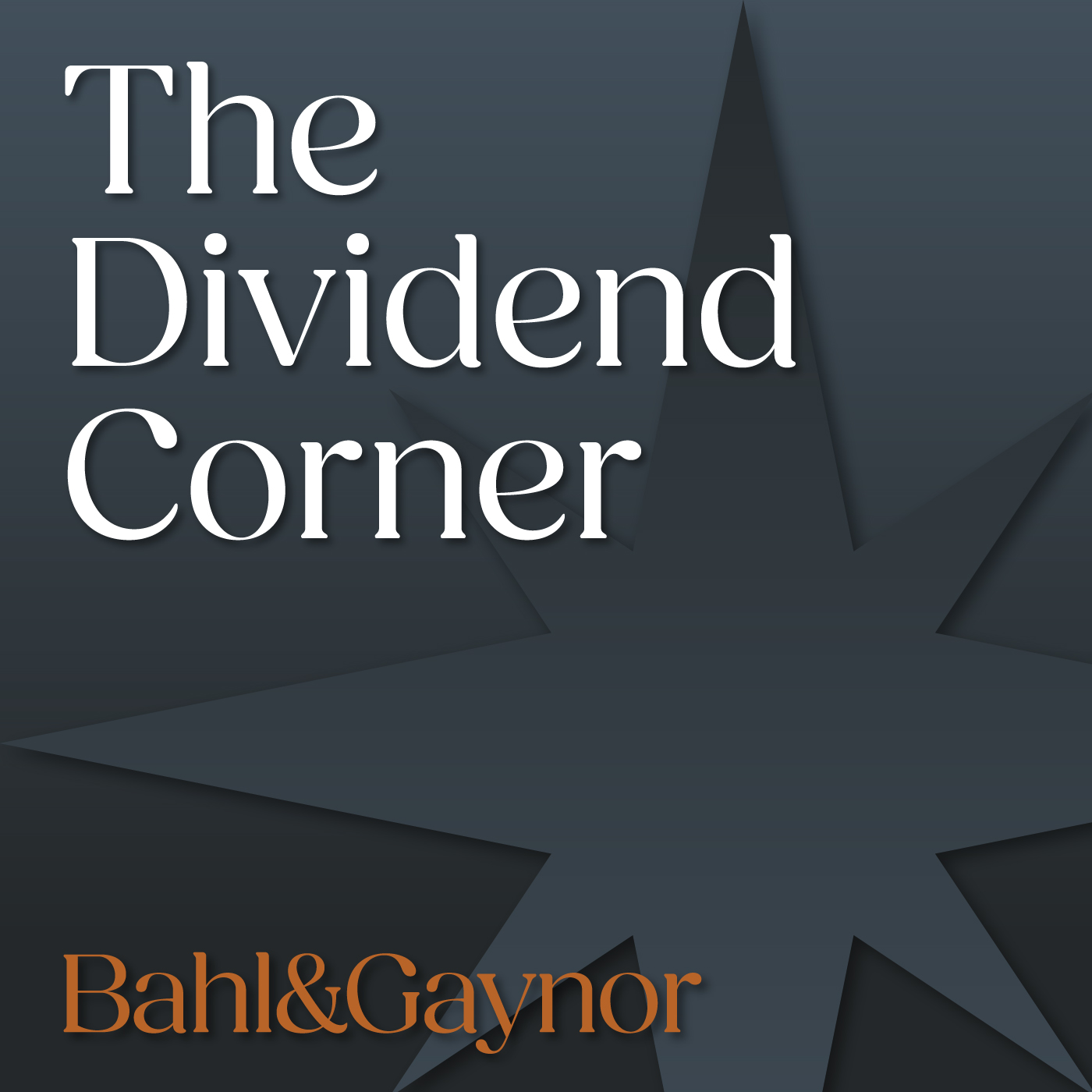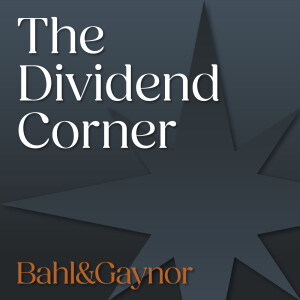
121
Downloads
4
Episodes
The Dividend Corner, a podcast dedicated to providing mid-market updates and key trends impacting financial Investments by our host, Nick Puncer, Portfolio Manager & member of the Bahl & Gaynor Investment Committee. These updates will provide insights into our unique dividend growth investment approach, along with trends in macroeconomic shifts, and the impact on investments. Expert perspectives will take place through each episode, with in-depth conversations brought by the Bahl & Gaynor investment team.
Episodes

2 days ago
2 days ago
Hi, I’m Nick Puncer, Portfolio Manager and member of Bahl & Gaynor’s Investment Committee. Welcome to our fourth episode of The Dividend Corner, following our mid- quarter update published in late May. Today is Monday, June 30, 2025 and what a start to summer it has been!
Markets have staged an impressive comeback following the “Liberation Day”-induced drawdown of the first quarter. The recovery has been impressive in both its speed and magnitude. Given the full summer lies in front of us, our thoughts this quarter will be compact. This is partly an acknowledgement of a season replete with vacations, time with family, and conditions ripe for thought and reflection — but also a recognition of how little has changed with respect to the underlying market risks we’ve highlighted previously, and Bahl & Gaynor’s role in addressing them for investors.
Toward the end of last year, we continued to raise concerns about market concentration, high valuation levels, and lofty earnings expectations amid gathering storm clouds. A market priced for perfection was inherently more sensitive to any disruption of the growth narrative. The source of disruption in the first quarter came in the form of heightened trade policy uncertainty, leading the market to correct nearly 20% from its intra-year highs.
Many of our conversations going into the end of the second quarter have centered upon “clearing the smoke”, so to speak, around traded policy uncertainty, Fed policy considerations, and other “known unknowns.” Because these variables are unknowable in the near and perhaps even medium term, clearing the smoke entails returning to basics: where we are now, where we may go from here, and most importantly, how to position for it. The fact pattern of where we are now goes something like this:
- First, markets have mounted an enormous comeback from the drawdown that began in the first quarter and bottomed out in early April, surpassing prior all-time highs at the time of this recording.
- Second, there has been little improvement in key economic metrics or “hard data.” If anything, some of these metrics have softened recently, likely reflecting the lagged impact of trade disruption. Therefore, the market’s recovery has been sourced largely from a recovery in sentiment (read: emotion).
- Third, earnings growth expectations have been dented because of the various growth disruptions mentioned, and their future path remains as uncertain as the timeframe for the resolution of top-of-mind risks for investors such as fiscal policy, trade policy, and the Iran/Israel conflict, to name a few.
- Taken together, this fact pattern means the market has returned to high levels of concentration, valuation, and susceptibility to changes in the growth narrative — a similar position to the closing months of 2024.
Where we may go from here is anybody’s guess. That said, the last two quarters have been enormously useful to investors because the drawdown and subsequent recovery has granted them a “free preview” of risk present in their portfolios as currently allocated. We cannot overstate the importance of this opportunity. If our conversations with clients and prospects — as well as the flow of new capital into our strategies — are a representative indicator, we believe investors held more risk exposure than may have been ideal for their circumstances going into the first-quarter drawdown.
Now is the time to make thoughtful changes to risk profiles so the progress investors have made over the last decade of excellent equity returns is protected, and so they sidestep serious market risks that have recently tested the behavioral limitations of investors to withstand high levels of volatility.
We want to conclude this quarter’s update by highlighting the fact pattern that Bahl & Gaynor offers across its strategies that can address the re-emergence of significant market risks and help investors remain optimally positioned to achieve their goals amid an uncertain future:
- We begin with the concept of upside and downside capture. Bahl & Gaynor’s strategies have historically demonstrated upside capture ratios amid market rebounds that are relatively consistent with downside capture ratios experienced during drawdowns. Year-to-date upside capture ratios across our strategies have ranged from 63% to 76%. These metrics reflect performance during recent market conditions and are based on gross-of-fees results, so investors would have seen a portion of the recovery relative to the market — though actual results may differ depending on fees, timing, and portfolio composition – but with less volatility.
- Earnings and dividend growth stability are another important concept. Though the companies we invest in are not immune to growth disruptions, we seek to identify quality companies with ample flexibility to navigate uncertain environments. As a result, our portfolios continue to deliver stable earnings profiles and dividend growth that is little changed from our estimates at the beginning of the year. This stability helps to ensure client goals remain funded as previously expected, and that the compounding so vital to successful equity investment is not disrupted.
- In our last few investor letters and mid-quarter updates, we’ve highlighted the extreme levels of concentration in passive equity indexes. Though these concentrations are not occupied by poor business models, they have left equity indexes more volatile than in the past. Bahl & Gaynor’s strategies are actively managed to promote diversification, which may help support more predictable outcomes compared to unmanaged index exposure. This diversification allows us to make thoughtful portfolio adjustments as fact patterns change rather than “hoping” the market consensus is infallible.
- Alongside our discussions of downside protection potential through quality exposure and diversification, we have also discussed the protection potentially afforded by valuation discipline. At the end of 2024, valuation levels of our strategies were several turns lower than their respective benchmark indexes, offering an added layer of protection amid the valuation compression that occurred through the first-quarter drawdown. That favorable valuation differential still exists today, even as the market has recovered, and we believe it will continue to serve investors in the form of added protection potential if the growth narrative is disrupted yet again.
We wish readers of this publication an enjoyable and safe summer ahead. We believe that the outcomes our strategies have delivered during this recent drawdown and recovery — including growing income, reduced downside risk exposure, and attractive risk-adjusted returns — can provide valuable support for clients’ financial peace of mind.
We thank those of you who have entrusted your or your clients’ capital to our care. And for those reassessing risk and portfolio positioning during these sun-drenched months ahead, we are confident in our ability to help move risk in a direction that can support critical outcomes for the investors we serve.
Disclosure:
Please note that the information provided in this update is for informational purposes only and does not constitute investment advice or a recommendation by Bahl & Gaynor.
Before making any investment decisions, please consult with a qualified financial professional to ensure the information is appropriate for your individual circumstances.
Bahl & Gaynor is a registered investment adviser with the Securities and Exchange Commission (SEC), and all discussions in this update are subject to the firm’s disclosure documents, including Form ADV Part 2A and Part 2B, which are available upon request.
This is not an offer to buy or sell any securities or investments. Any examples or information related to specific securities are for educational purposes and should not be considered a solicitation or recommendation.
Downside and upside capture ratios are supplemental performance measures calculated using gross returns of Bahl & Gaynor representative large-cap and small/mid-cap strategy composites compared to the S&P 500® Index during down-market and up-market periods, respectively, for the YTD period through June 30, 2025. The S&P 500® Index is an unmanaged index that cannot be invested in directly.
This podcast contains forward-looking statements that reflect the current views of Bahl & Gaynor at the date of recording. These statements are not guarantees of future performance and are subject to risks and uncertainties that may cause actual results to differ materially. For complete net performance information, including 1-, 5-, 10-year, and since-inception figures, please refer to the full GIPS-compliant presentation available upon request at info@bahl-gaynor.com.
Past performance is not indicative of future results. Investing involves risk, including the potential loss of principal.

No comments yet. Be the first to say something!